In the world of dogs, some breeds are known for their speed. The swift Greyhound, the ever-energetic Border Collie, the lithe Saluki. But what about the stalwart Rottweiler? With their muscular frame and imposing stature, Rottweilers conjure images of power more than fleetness of foot. And yet, these dogs have a long history intertwined with human movement, originally used to herd livestock over miles of terrain.
So, how fast can a Rottweiler run when put to the test? What factors impact their speed and endurance? As a long-time canine lover and Rottweiler owner, I decided to dig into the details and myths around this breed’s running capabilities. Leash up and join me as we explore the origins, anatomy, speed measurements, and health considerations that reveal the athletic side of this often misunderstood dog. With the wagging tail, let’s begin.
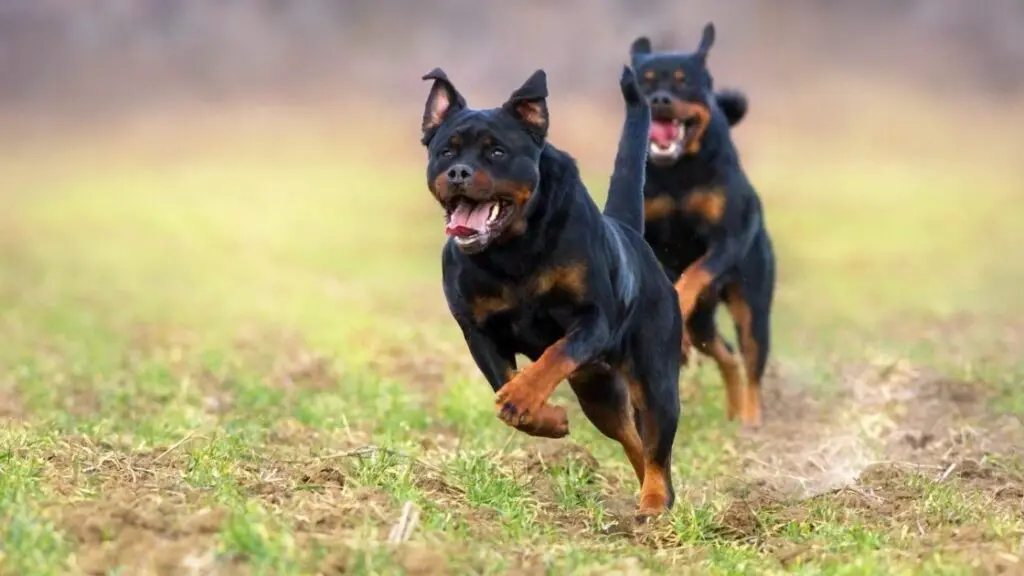
Table of Contents
- 1 An Ancient Breed Built for Movement
- 2 The Makings of Muscular Speed
- 3 Fleet of Foot: Factors that Impact Rottweiler Speed
- 4 Built for Power, Not Endurance
- 5 Measuring Your Rottweiler’s Speed and Endurance
- 6 The Health Benefits of Running for Rottweilers
- 7 Safety First When Running With Your Rottweiler
- 8 Related posts:
- 9 Rottweiler Puppies (25 Gorgeous Pups)
- 10 Are Rottweilers good for jogging?
- 11 The Truth About Rottweiler Aggression: Debunking Myths and Promoting Responsible Ownership
- 12 Rottweilers Running
An Ancient Breed Built for Movement
Like most working dogs, the Rottweiler breed traces its origins back centuries, with depictions found on Roman frescoes dating as far back as 74 A.D. Their name derives from the town of Rottweil in Germany, where these dogs likely descended from ancient Roman drover dogs that marched over the Alps alongside Roman legions.
Given this history, the Rottweiler was built for movement and speed from its early days. Their original purpose was to herd livestock and pull carts loaded with meat and other goods to market. This required strength, stamina, and athletic prowess. Rottweilers needed to be able to run miles at a time alongside cattle, keeping the herd packed together and safe from threats. Even today, traces of this history can be seen in the Rottweiler’s muscular yet agile form. Their broad chest provides lung capacity, while their heavily muscled hindquarters contain explosive forward power for sprints and rapid changes in direction.
When my own Rottweiler Luna breaks into an unexpected darting chase after a deer on our morning hike, I can easily envision her ancient ancestors doing the same generations ago across the European countryside.
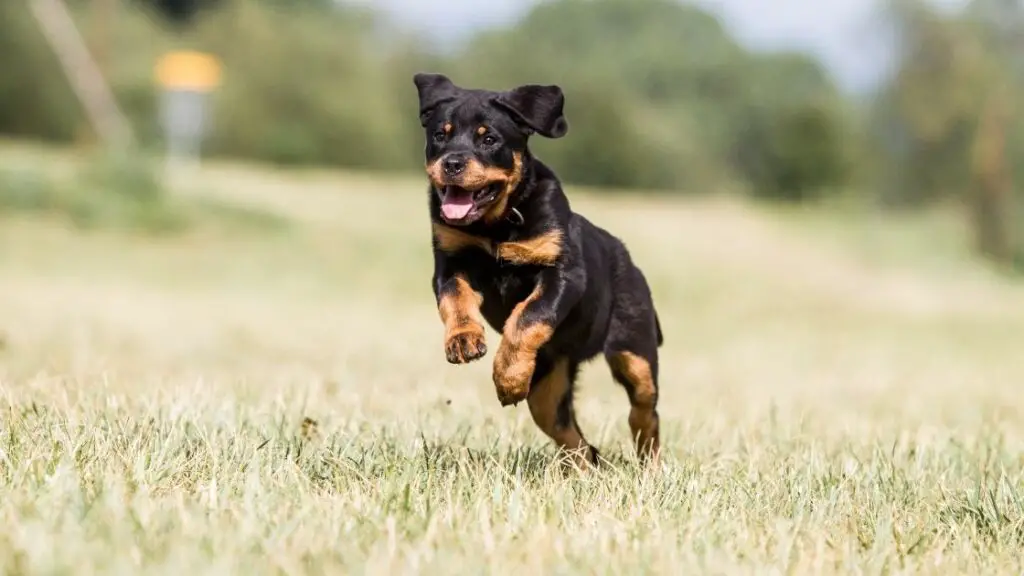
The Makings of Muscular Speed
Rottweilers have naturally muscular physiques like many guard dogs, including boxers, bulldogs, Dobermans, and Pitbulls. To build muscle on a Rottweiler, it is crucial to ensure they get sufficient physical activity starting as a pup. As my boy Max grew from a roly-poly ball of fur to a strapping adolescent, our long, meandering walks became jogs broken up by games of fetch. This combination of cardiovascular exercises like running and swimming and resistance training through activities like tug of war builds powerful muscles while increasing endurance.
Rottweilers have mighty hind legs that support their solid, sturdy body frame. These heavily muscled hind legs contribute to their startling bursts of speed and rapid lateral movements. I’ve seen 3-year-old Max nearly twist himself in knots trying to keep up with a squirrel zipping across our lawn! Along with leg strength, Rottweilers possess a robust cardiovascular system to maintain stamina over long distances. However, owners need to be mindful of potential health issues like hip dysplasia, a genetic propensity for abnormal hip development that can limit mobility if not carefully managed. With the proper care, those muscle-bound legs will carry your Rottweiler with piston-like power and endurance.
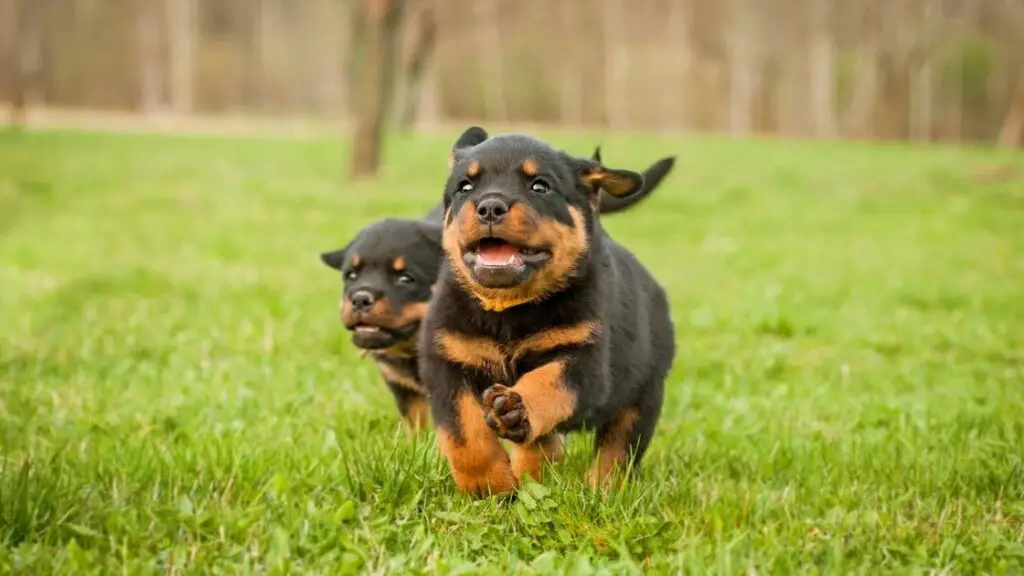
Fleet of Foot: Factors that Impact Rottweiler Speed
While Rottweilers can impress with their speed and agility, many factors influence how fast this breed can run. Here are some key considerations:
Age: Given their large size and muscular frame, Rottweilers take time to mature fully and should not engage in excessive running while still developing joint strength as puppies. While Rottweilers can reach speeds up to 25 miles per hour at a full sprint, younger dogs under 18-24 months lack the skeletal support for such exertion. Likewise, senior Rottweilers over age eight require adjusted exercise to avoid injury. Know your dog’s limits.
Health: Rottweilers are prone to several musculoskeletal issues in addition to hip dysplasia, including cruciate ligament ruptures, osteoarthritis, and elbow dysplasia. Obesity can stress already vulnerable joints. Any existing or emerging health conditions will impact your dog’s speed and running ability. Regular vet check-ups are a must.
Training: As trainable working dogs, Rottweilers thrive on daily activity and exercise. Regular running, swimming, and agility training build muscle tone while keeping excess weight off. This enhances both speed and endurance. Always start slowly with puppies, though, gradually increasing duration and intensity as they mature. Proper warm-ups and cool-downs help prevent injury, too.
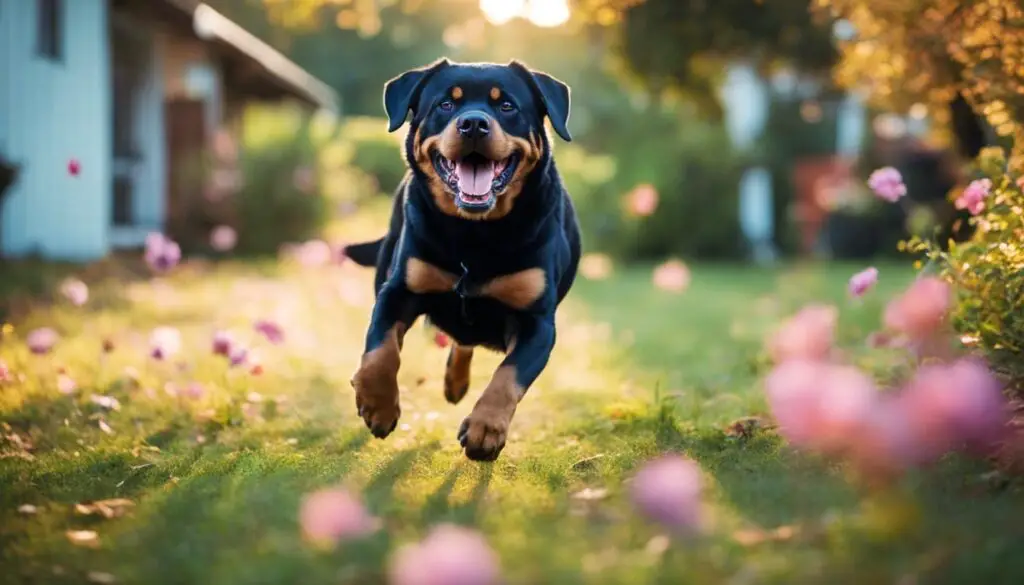
Environment: Different terrains and conditions affect a Rottweiler’s optimal running speed. While reaching speeds of 25 mph on grass, thick snow or mud can reduce that by half. Running up hills requires more exertion a slowing pace. Overheating is always a risk, so avoid concrete or asphalt on hot days since Rottweilers are prone to heat exhaustion. Know your environment.
On a cool spring morning, I delight in watching Max explode in a blur of black fur as he sprints at top speed across the spongy lakeside meadow during our weekend hike. Tail flagged out straight, eyes bright with joy, he reveals his athleticism in a natural setting he was born to run in alongside his human partner.
Built for Power, Not Endurance
While able to impress with short bursts of speed, it’s essential to remember that Rottweilers differ from ultra-endurance breeds like Huskies or Australian Shepherds that can run marathon distances tirelessly. Rottweilers are sprinters rather than long-distance runners. Their body structure favors strength and power over lean lightness. Consider that a Greyhound, built for raw speed with a more elongated frame, sleek coat, and light bone structure, can run 35 – 40 mph at full gallop.

I learned this distinction quickly with my first Rottweiler Samson, who loved charging ahead at the start of every walk before collapsing in an exhausted heap halfway through our neighborhood stroll. For longer hiking trips in the mountains, I always packed plenty of water and allowed extra time for rest breaks to prevent overheating. Rottweilers will push themselves to keep up with more athletic breeds without realizing their limits, so owners must monitor them closely on runs.
While not marathon runners, Rottweilers still require at least 60 – 90 minutes of daily exercise to stay fit. This can be broken into multiple shorter sessions. Activities that strengthen muscles without excessive pounding on joints are ideal. In addition to brisk walks, games of fetch, and swimming, I’ve taught Max and Luna various agility skills using ramps, tunnels, and balance equipment. This builds whole-body coordination while avoiding repetitive pavement pounding. Massaging and stretching those hard-working muscles post-exercise helps reduce soreness, too.
Measuring Your Rottweiler’s Speed and Endurance
If you’re curious about your dog’s running speeds, there are several ways to measure this while monitoring for signs of fatigue or soreness. Here are some options:
Stopwatch: Using a phone or stopwatch, how long does it take your Rottweiler to run a certain distance, say 100 yards? Calculate the speed by dividing the space by completion time. Repeat several times and average.
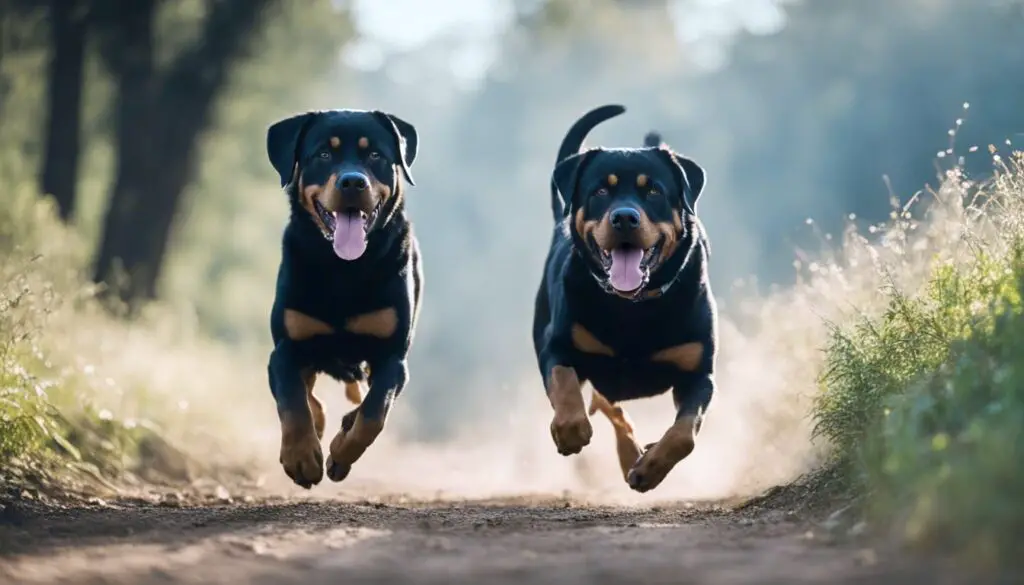
Apps: Mobile apps like MapMyDogWalk and WalkForADog use phone GPS to calculate the speed and distance traveled during your exercise sessions. Just note that phone accuracy can vary.
Fitness Trackers: Place a fitness watch with speed and distance tracking capabilities like FitBark or Whistle on your dog’s collar to collect data during play. Compare speeds on different terrain.
Pedometers: These wearable step counters attach to collars to record strides taken and distance covered. Since a Rottweiler’s stride length is around 38 inches, you can use counts to approximate speed over a set time.
Regardless of the method, I constantly monitor breathing and energy levels during and after exercise. Excessive panting, lagging, or limping all signal a need to slow down and rest. Pace your pooch appropriately for their age, environment, and breed traits. Safety first!
The Health Benefits of Running for Rottweilers
While Rottweilers lack long-distance running genes, regular jogs and sprints offer many benefits when done safely. Physical activity enhances health in both body and mind.
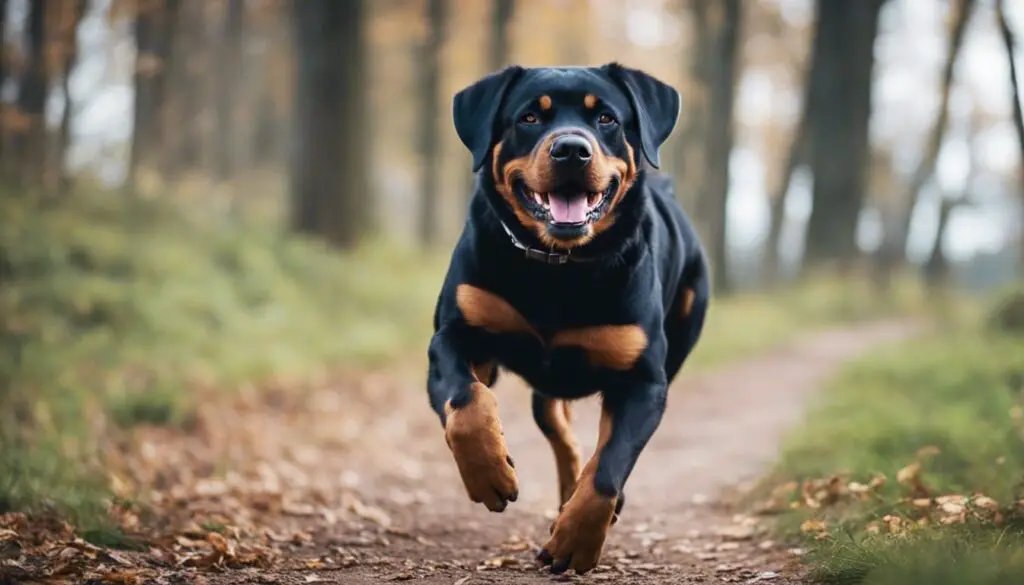
Running helps build cardiovascular endurance, muscle tone, and joint agility for overall fitness when properly conditioned at growth. Physically tired dogs also tend to be better-behaved, expending pent-up energy in healthy play rather than destructive chewing at home. Mentally, running releases feel-good endorphins that can lessen anxiety and frustration. The focused teamwork of running alongside their owner satisfies the work drive bred into Rottweilers.
As a Rottweiler owner, I constantly balance exercise needs with injury risks. Off-leash running lets Max and Luna indulge their joy of speed while monitored fetch sessions on softer grass surfaces limit pounding to growing joints. Swimming and cool-downs provide recovery time. I observe for signs of fatigue, soreness, or changes in gait that signal a need to adjust activity levels. With the right balance, running benefits muscles, the mind, and relationships.
Safety First When Running With Your Rottweiler
Speaking of relationships, running together deepens the bond between dogs and humans. But only if done safely! Here are some critical tips on running with your Rottweiler buddy:
- Avoid heat: Rottweilers are prone to overheating and heat stroke. Run during cooler times of the day and provide ample hydration.
- Mind the feet: Check terrain for sharp objects. Running on abrasive or too-hot surfaces can injure sensitive paw pads.
- Gear up: Use a well-fitted running harness designed to avoid excessive jarring. Add reflective gear for visibility.
- Build conditioning: Start with short distances and easy speeds. Gradually increase distance and pace as the dog’s fitness level improves.
- Watch for fatigue: If your Rottweiler slows, pants excessively, or drags behind, it’s time for a break. Carry water on longer runs.
- Limit pounding: Avoid excessive running on hard or uneven surfaces to reduce concussive injuries to joints when bones are growing.
- Make it fun! Run at your Rottweiler’s pace, not your own. Let them explore and set the course at times. Celebrate new distances achieved.
When freed to run with reckless doggie abandon, the joyous look on a Rottweiler’s face is truly a sight to behold. As owners, we must honor the athleticism bred into this noble working breed while staying vigilant to prevent injury. Your loyal companion will be happy and healthy for years with proper care.
Until next time, keep on talking to your dogs! Woof!